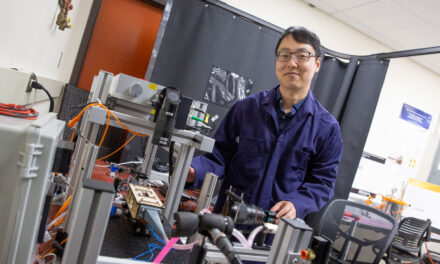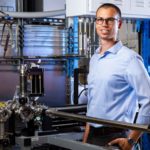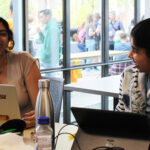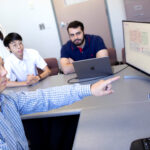
Federal stimulus grants give boost to ASU research
September 28, 2009
Arizona State University researchers to date have received more than $39 million in stimulus package research grants. For ASU, which has played a very active role in attracting this additional funding, much of these research funds have gone for projects that meet challenges currently confronting society.
Projects funded include work to unlock the secrets of photosynthesis for new sources of energy; research into a computational understanding of the skills required in surgical training; development of a new method for screening and diagnosing tuberculosis in children; a study on child development and immigrant adaptation; and development of a new type of robotic hand.
Funds for these projects come from the Department of Energy, the National Institutes of Health and the National Science Foundation, says Sethuraman “Panch” Panchanathan, ASU’s deputy vice president for research and economic affairs.
“Funding for these projects come at a critical time as we look to finding new sources of renewable energy, smarter ways of diagnosing and fighting diseases, and better ways to educate our next generation workforce,” Panchanathan says. “Now is the time to invest in bold new ideas that result in large scale innovation and entrepreneurship.”
The research funds are part of the $787 billion American Recovery and Reinvestment Act (ARRA), the federal economic stimulus package approved in February. Several federal agencies have been allocated a portion of this money for funding competitive research proposals from universities for work on basic and applied research in critical areas of national importance.
These grants are restricted to use for specific research projects and cannot be used to fund general university expenses. However, they do add a significant amount of money to the state economy.
The ASU projects involve teams of researchers from across the university and across the country. This leverages ASU’s strength in interdisciplinary research, Panchanathan says. Highlights of ASU’s newly funded projects include:
Power from sunlight
One grant awarded ASU — $14 million for five years — has come from the Department of Energy to set up an Energy Frontier Research Center that will focus on research on solar energy conversion based on the principles of photosynthesis. The goal of ASU’s new center is to design and construct a synthetic system that uses sunlight to convert water cheaply and efficiently into hydrogen fuel and oxygen.
Society requires a renewable source of fuel that is widely distributed, abundant, inexpensive and environmentally clean. The use of solar energy to produce a clean fuel such as hydrogen is essentially the only process that can satisfy these criteria at a scale large enough to meet the world’s energy demands.
Plants and similar organisms use photosynthesis to oxidize water, producing oxygen and fuel compounds such as carbohydrate and hydrogen. The system to be developed in the ASU center will be designed using principles borrowed from these natural processes.
“This grant will allow us to put together a complete system that starts with the absorption of sunlight and ends with the creation of a clean fuel, such as hydrogen,” says Devens Gust, an ASU professor of chemistry and biochemistry who is director of the new center.
“It also will provide resources to educate students at all levels about renewable energy, and it could lead to whole new industries,” Gust adds.
Easier diagnosis of pediatric TB
A grant of $107,700 from the National Institutes of Health (NIH) to Robert Husson at Children’s Hospital in Boston and Joshua LaBaer, director of the Virginia G. Piper Center for Personalized Medicine at ASU’s Biodesign Institute, will improve methods for detecting tuberculosis (TB) in children.
An accelerating TB epidemic in settings where HIV is highly prevalent demands new tools for TB control. One area of great need, especially for pediatric TB, is improved diagnosis. The standard approach of sputum smear microscopy and culture are insensitive, especially in children and in HIV infected persons of all ages. They also require laboratory resources and skilled personnel.
LaBaer has been working with his colleague in Boston on new, high throughput technologies in the field of functional proteomics, which seeks to understand the roles proteins play in the human body. In this project, LaBaer will produce microscopic arrays of Mycobacterium tuberculosis proteins that can be screened with patient serum to identify antigens of that can be used to develop new anti-body based tests for TB in children.
Helping children improve their oral language
A $130,527 grant from the NIH is helping ASU researcher Shelley Gray tackle the challenges that children with Specific Language Impairment (SLI) face in trying to understand and use new words.
Children with SLI often have poor vocabularies. It is not that they cannot learn new words, but they require significantly more exposure to new words before they can store sufficient phonological and semantic information to recognize and produce them. This has a negative impact on their oral language and literacy development, especially reading comprehension.
This project is investigating whether phonological or semantic encoding or retrieval cues help children with SLI learn new words faster, says Gray, an ASU associate professor of speech and hearing science.
“Faster word learning will result in a larger vocabulary,” Gray says. “This is crucial for preventing reading comprehension problems and for closing the academic gap between children with SLI and children with typical language development as they progress through school.”
Child development and immigrant adaptation
School can be tough on any child, but for children new to the U.S., it can become an ordeal as they try to acclimate to a new school and a new country. With a $221,575 NIH grant, Jennifer Glick, an ASU associate professor in the School of Social and Family Dynamics, will take an integrative approach to study child development and immigrant adaptation.
Children of newly arrived immigrants can find many ways to adapt in the U.S. depending on the resources of the family and the interactions they receive in the community. If society fails to support immigrant adaptation, it’s expected that the child’s school performance will suffer.
However, the child’s family and ethnic community may bring additional resources to the education sphere. Thus, the interaction of family background, parental involvement and community context all will influence developmental and educational outcomes for children in immigrant families. A key goal of this study is to go beyond using immigrant status as a proxy for other traits to determine how family migration context — including parent’s age and arrival, language background and use, national origins and ethnicity — are related to school readiness and early academic progress.
“This project is a multi-disciplinary approach, combining theoretical perspectives of immigrant adaptation and child development,” says Glick, who studies immigrant adaptation and family survival strategies. “We are looking for a better understanding of how the school performance of immigrants’ children is advanced by the family context in which they live.”
Training a surgeon’s hand
In any field, good training improves skills. This is as true for airplane pilots as it is for surgeons. The more you do, the better you become. But when it comes to training surgeons, there is an associated need to cut training costs that can compromise training quality.
An $874,484 grant from the National Science Foundation will allow Baoxin Li, an assistant professor in ASU’s School of Computing Informatics & Decision Systems Engineering, to overcome this quandary by exploring simulation-based surgical training.
“Our goal is to come up with a system that can shorten the time involved in training a surgeon and improve the quality of the training,” Li says.
But to do this Li needs to come up with a system that can do several things, including monitoring and measuring a surgical resident as she performs a procedure and then being able to put value judgments on what the system sees during the exercise, and to associate skill ratings with correction procedures.
“We present a machine-learning based approach to computational understanding of surgical skills based on temporal inference of visual and motion capture data from surgical simulation,” he says. “This learning approach is enabled by our simulation and data acquisition design that ensures clinical meaningfulness of the data.”
A simpler grasp
Because the human hand is an evolutionary marvel, it is incredibly hard to replicate and employ on a machine, like a robot. For example, says Marco Santello, an ASU professor of kinesiology, robotic grasping has been around for 25 years and yet there are no successful devices for grasping in unstructured environments.
“The new generation of highly successful mobile and humanoid robots still lack basic ‘hands’ that can reliably grasp arbitrary objects,” Santello says.
That may change as a three-year, $236,000 National Science Foundation grant to Santello and a team of researchers (Peter Allen, Columbia University, and Robert Howe, Harvard University) will let them explore new ways of developing simpler grasping devices for robots. The work is based on four basic principles: begin with robust grasping as the goal; learn from the human hand but do not replicate it; simplicity is essential; and put functionality in passive mechanics, not in elaborate sensing and control. Experimental work at ASU, involving graduate and undergraduate students, will aim to understand how the brain controls dexterous manipulation activities.
Using these ideas, “we propose to build a low-cost, low degree of freedom grasping device that is based on hard human grasping data,” Santello explains. “We will test the new tools in simulation and build hardware that is functionally proven for a given set of robotic grasping tasks.”
Panchanathan says that ASU faculty have responded rapidly and strategically to acquire stimulus research grants. To date, ASU researchers have sent in proposals totaling nearly $410 million in research funding.
“ASU faculty and researchers have put forth tremendous efforts to secure stimulus funding in a highly competitive environment,” he adds. “We are pleased with our success thus far and are looking forward to securing a number of new projects over the next year. This will allow us to not only contribute significantly towards solving challenging problems faced by society, but also result in a significant economic impact.”



































